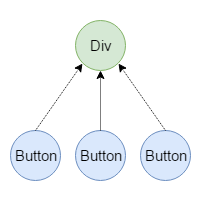According to the results of the 2018’s StackOverflow survey, JavaScript is the most popular technology. The amount of job offers for JavaScript developers is constantly increasing and with more companies adopting JavaScript as their main language, it’s easy to find
Event delegation in JavaScript

One of the most common tasks a web developer deals with is to add event listeners to the elements of a page. Event listeners are employed to perform one or more actions when a given event occurs on one or more elements.
For example, by using an event listener we could display a dialog when a button is clicked by a user. In this case, the developer is running a single action (showing the dialog) when a click event occurs on one element (the button). Another example is a pagination widget. The latter is made of many links that have to lead the user to a given page when clicked. Here, the developer is performing the same, single action on many elements. The final example I want to mention is to use an event listener with elements that don’t yet exist in the page but will. This happens when injecting elements in the web page after an Ajax request is performed.
In this article, I’ll discuss how you, as a web developer, can optimize the addition of event listeners in all these situations by employing a technique called event delegation.
An in-depth guide to event listeners
When creating interactive web pages, developers often need to execute some actions when a given event occurs. Changing the image of a carousel when a user clicks on one of its arrows, showing a tooltip when a word is hovered, or validating a field when a user moves the focus onto another field are common examples. To execute these actions, we have to add event listeners to the elements of the page.
In this article, I’ll explain what event listeners are, and how to add and remove them from a web page. I’ll show several examples and talk about patterns to avoid when dealing with event listeners. The topic will be discussed in depth. So, even if you’re an expert, you might not know some of the details covered.
From JavaScript developer to JavaScript engineer: find all celebrities in a set of people

In the first article of my series From JavaScript developer to JavaScript engineer titled From JavaScript developer to JavaScript engineer: Re-implementing ECMAScript 2015’s String.prototype.repeat() method I’ve discussed how computer science concepts can help in writing better and more elegant software. Specifically, I’ve demonstrated how to use appropriate algorithms and data structures, together with techniques like memoization, to re-implement the String.prototype.repeat() method so that it’s blazing fast.
In this second article of the series, I’ll discuss how important is reasoning about the problem we’re facing. To do that, I’ll analyze the problem of finding all celebrities in a set of people.
If you want to take a look at the final solution, you can either go to the section An efficient solution or browse my Interview questions repository on GitHub.
From JavaScript developer to JavaScript engineer: re-implementing ECMAScript 2015’s String.prototype.repeat() method

As developers, our work is to solve problems which often implies writing code. Some of the problems we face look really simple in nature, but their simplicity leads us to write sub-optimal solutions without even realizing it. JavaScript developers come from very different backgrounds, and assuming that everyone has the same base knowledge of computer science is, at least, misguided. However, we should strive to gain understanding of this field as computer science concepts can help in writing better and more elegant software.
In this article, the first of a series titled From JavaScript developer to JavaScript engineer, I’ll discuss how to re-implement ECMAScript 2015’s String.prototype.repeat() method. What this method does, repeating a string, is pretty simple and a basic implementation would be simple as well. But by using appropriate algorithms and data structures, we can heavily improve the performance of this method.
If you want to take a look at the final solution, you can either go to the section An efficient solution or browse my Interview questions repository on GitHub.
Monkey patching in JavaScript

When working on a project, we often use libraries that implement methods that aren’t built-in in the programming language in use but we need. These libraries don’t cover all the possible methods, so they might lack one or more crucial features we need. When this happens, we have two choices: the first is to create our own module that implements the methods we need, the second is to add those methods to the library itself or the built-in classes of the language. The latter is known as Monkey patching.
In this article, we’ll look at what Monkey patching is, what pros and cons it has, and also a couple of examples that employ this technique.
My most used npm commands

If you’re a front-end or a JavaScript developer, you’re surely using npm. npm is a registry where people publish their software. At the beginning, it was used to share JavaScript libraries and frameworks, but today you can also find CSS frameworks, font icons, and much more. In addition to being a registry, npm has also its own client that allows to manage the dependency of a project. Through the npm client, you can install, update, delete packages published on the npm registry and not only.
In this article, I’ll discuss the less known npm commands I use the most.
5 reasons why you should start writing technical articles

A few weeks ago, LinkedIn has reminded me that it was four years ago (on ) when my first technical article, titled Create Your Own HTML5 Environmental Thermometer, went live. The article was published by SitePoint at a time where the editor was Tom Museth (still thank you for that!).
This anniversary has made me think about what writing technical articles has meant to me and what benefits it has provided to my career. In this article, I’ll share 5 reasons why you should start writing technical articles.
The power of simplicity in code

A few days ago I found an online test featuring six exercises on JavaScript. For fun, whishing to challenge myself with something tricky, I decided to take it. The test proved to be very simple, so it isn’t worth a discussion. It’s what happened next that inspired this article.
I was talking with a workmate about the test and he decided to take it despite my warning about its simplicity. We compared the solutions we wrote for two of the six exercises and we found out that they were quite different: his solutions were terse and clever, mine were long and extremely simple in their approach to the problem. These differences have generated an interesting discussion that touched several topics: readability, complexity, performance, and maintainability.
Starting from the analysis of the two exercises we compared and the solutions we wrote, in this article I’ll share my thoughts about the power of simplicity in code.
The revolution of 3-spaces code indentation

Almost 10 years have passed since that moment and I’ve changed my conventions quite a lot. But there is one thing that isn’t changed and I’m still firmly advocating: the use of 3 spaces to indent the code. Now, I know that some of you might have already labeled me as crazy, but when it comes to code conventions there isn’t a truth or a way better than other. It’s all about tastes.
Despite the catchy title, I don’t think I’m revolutionizing code indentations with my proposal. What I know for sure is that 3 spaces aren’t used a lot to indent code. This is proved by the fact that none of the in-browser developer tools gives you the option to set 3 spaces. They all give you the choice between 2 and 4 spaces, and tabs (or 8 spaces). I don’t know if this post will convince someone to change his convention or at least to give 3-spaces code indentation a try, but I still want to share my opinion.